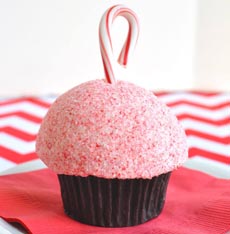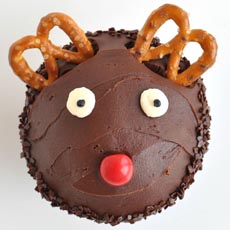Christmas Cupcakes From Scratch Or Decorate Store-Bought
|
December 15th is National Cupcake Day (there are 8 more cupcake holidays). When a holiday like this falls right before Christmas, there’s only one way to go: Christmas eat cupcakes. We have great ideas for you, but first, for your consideration: > The history of cupcakes is below. > The different types of cake: a photo glossary. > The year’s 55 cake holidays. You can turn thi food holiday into a seasonal holiday party, with a DYO (decorate your own) cupcake party, with holiday flavors and garnishes. Whether you bake them from scratch or buy plain cupcakes to decorate, here are 10 easy approaches: |
 [1] Crushed peppermint and a mini candy cane, at Trophy Cupcakes (photos #1 and #3 © Trophy Cupcakes).
|
|
|
CUPCAKE HISTORY Before the advent of muffin tins, cupcakes were baked in individual tea cups (hence “cup” cakes) or ramekins. The first reference to these miniature cakes dates to 1796 when a recipe for “cake to be baked in small cups” appeared in the cookbook, “American Cookery.” The earliest documentation of the term “cupcake” was in Eliza Leslie’s Receipts cookbook in 1828 (receipt is an earlier term for recipe). [Source] Back then, cupcakes were easier to make than cakes because they cooked much faster. It took a long time to bake a cake in a hearth oven; cupcakes were ready in a fraction of the time. [Source] Muffin tins (doing double duty as cupcake tins) became widely available around the turn of the 20th century and offered a new convenience to bakers of muffins and cupcakes. But the next convenience took a while longer: For easier removal of cupcakes from the pan, paper and foil cupcake pan liners were created after World War II. An artillery manufacturer, the James River Corporation, began to manufacture cupcake liners when its military markets diminished. By 1969, they left artillery manufacturing behind and became a paper manufacturer. During the 1950s, the new paper baking cup gained popularity with U.S. housewives. Its popularity grew, even more, when bakers realized that they could bake muffins as well as cupcakes in the baking cups [source]. Cupcakes evolved into children’s party fare, but in the last decade, they have taken a more sophisticated turn. First, some younger couples began to choose “cupcake trees” instead of conventional wedding cakes. This prompted a flurry of cupcake articles and recipes, and ultimately the opening of boutique cupcake bakeries nationwide, offering what has become an everyday treat. *Both receipt and recipe derive from the Latin recipere, to receive or take. Receipt was originally used in medieval English to designate a formula or prescription for a medicinal preparation, and the symbol Rx emerged in medieval times. The sense of receipt as a written statement that money or goods have been received emerged later, at the beginning of the 17th century. In terms of cooking instructions, recipe became an alternative to receipt in the 18th century, gradually replacing it over time. Here’s more. CHECK OUT WHAT’S HAPPENING ON OUR HOME PAGE, THENIBBLE.COM. |
||




